
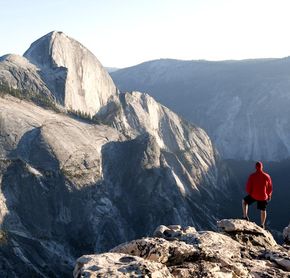

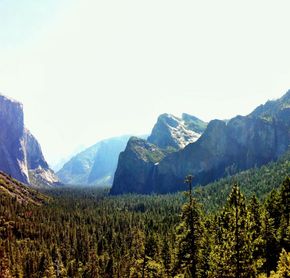
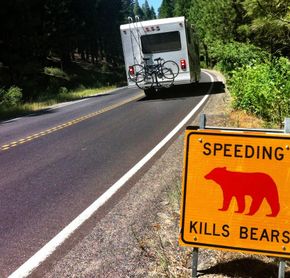
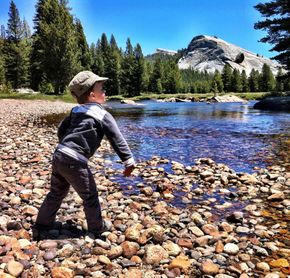
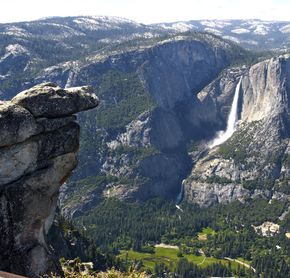
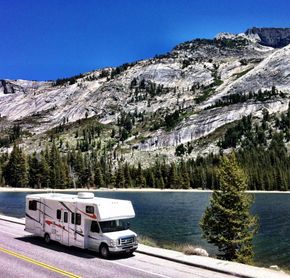

Yosemite National Park in the Sierra Nevada mountains is the third largest park in all of California, covering 3,079 km2.
The park welcomes more than 3.5 million visitors each year. The Yosemite Valley became the first area of land to be protected by the U.S. government in 1864.
Yosemite Valley offers breathtaking scenery with its towering granite cliffs, powerful waterfalls and giant sequoias, not to mention the astounding biodiversity that lives within this UNESCO World Heritage Site.
YOSEMITE NATIONAL PARKSeason: Open year-round, 24 hours a day. Note that Tioga Road is closed from November until late May/early June (Hwy. 120, between Crane Flat and Tioga Pass), as is Glacier Point Road, from November to May. Keep that in mind while planning your USA self drive holidays. Visitor centers:
* RVs longer than 30 feet are not allowed on Glacier Point Road (beyond Sentinel Dome/Taft Point) and vehicles longer than 25 feet (or 8 feet wide) are not allowed on Hetch Hetchy Road north of Mather. * You must reserve your access rights for the park (online) before your visit. |
YOSEMITE VALLEY
The Yosemite Valley section of Yosemite National Park, where most of the park's famous cliffs and waterfalls are found, is accessible by car and bus all year round.
Tunnel View
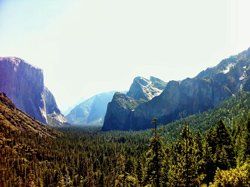
Tunnel View is the best viewpoint for iconic views (and photos) of Yosemite Valley. While best known for its mountains, the park also boasts thousands of lakes, two reservoirs and many waterfalls. It also has ancient giant sequoia trees (in Mariposa Grove), for anyone who doesn't have time to visit Sequoia and Kings Canyon National Park.
These landscapes are a reminder that, around 2 million years ago, this area was covered by glaciers that carved out the valley, leaving these natural monuments in their wake.
On the right you can see Bridalveil Falls , spilling from an enchanting hanging canyon into the pine-carpeted valley.
Across from the falls, to the left, is the sheer 2,307-metre face of El Capitan , one of the largest granite monoliths in the world. Its sheer size will impress you; it's easy to believe that it boasts one of the world's highest cliffs!
In the background, Half Dome looms over the end of the valley from a height of 2,693 metres, a massive formation resembling a dome cut in half with a dark band running across its sheer face.
Yosemite Falls
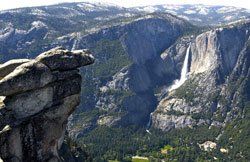
Yosemite Falls is a series of three falls which, taken together, form the third tallest waterfall in North America (739 metres) and the fifth tallest in the world. The falls are at their most magnificent in late spring, when water flow is at its peak from the melting snow and glaciers of the Sierra Nevada.
An easy 30-minute round-trip walk leads to the base of the falls (Lower Fall). You can also follow the Yosemite Falls Trail to the top of the Upper Fall, but it will take you 6 to 8 hours round trip.
Glacier Point
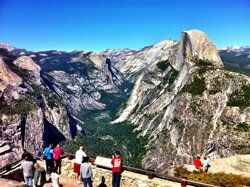 Glacier Point, a lookout with a breathtaking view of the Yosemite Valley, Half Dome and Yosemite Falls, is accessible by car and bus from late May to October or November. You can also get there by one of two hiking trails: the Four Mile Trail (difficult, 6 hours round trip) or the Panorama Trail (less steep, 10 hours round trip).
Glacier Point, a lookout with a breathtaking view of the Yosemite Valley, Half Dome and Yosemite Falls, is accessible by car and bus from late May to October or November. You can also get there by one of two hiking trails: the Four Mile Trail (difficult, 6 hours round trip) or the Panorama Trail (less steep, 10 hours round trip).
A short, paved, wheelchair-accessible trail leads from the Glacier Point parking lot to an exhilarating viewpoint 3,214 feet above Curry Village.
Visit Glacier Point at sunset and watch the valley fade into deepening dusk as the mountain peaks glow shades of pink and red. Note that the road was closed for 2022, and only accessible via trails. Visit the website for the reopening.
GOOD TO KNOWWatch out for the valley's inhabitants: it is important to remember that deer, coyotes and bears are part of the landscape. Drive slowly in the park and keep an eye out for animals: you'll enjoy the scenery more and avoid causing any accidents. As Yosemite National Park is home to hundreds of black bears, it is better to store food inside your vehicle, out of sight, with windows completely closed. Be sure not to leave any visible food wrappers, crumbs in baby seats, and even canned food and drinks, in your car. |
HIGH SIERRA
Tioga Road
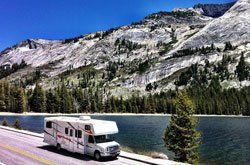
The Tioga Road is the highest trans-Sierra route in California, reaching an elevation of 9,945 feet at the Tioga Pass. It is a 45-kilometre scenic drive between Crane Flat and Tuolumne Meadows, passing through forests and past meadows, lakes, and granite domes. It has many turnouts offering spectacular vistas.
Today, the Tioga Road is a seasonal road used by more than 500,000 visitors every year. It is typically open from late May until November, depending on the weather conditions, and closes every winter.
Olmsted Point
Olmsted Point along the Tioga Road offers panoramic views of Tenaya Canyon and, in the distance, you can see Half Dome from a very different angle.
Tuolumne Meadows
Tuolumne Meadows is a large, open subalpine meadow graced by the winding Tuolumne River and surrounded by majestic peaks and domes. It is a wonderful place to go for a stroll and marvel at the beauty of your surroundings.
VISITING WITH AN RV?Since parking for RVs is limited in Yosemite, we strongly encourage you to leave your RV outside the park and use YARTS (Yosemite Area Regional Transportation System) to travel into the park. Not only will you be able to sit back and enjoy the scenery, you will avoid traffic congestion (there are reserved bus lanes) and parking problems. You will spend less time getting there and have more time to enjoy the park. YARTS operates from mid-May to early October and has 4 different routes. It offers service from the main towns around the park (Groveland, Mariposa, El Portal, Oakhurst, etc.) and even certain hotels and campgrounds (Yosemite Lakes Campground, Yosemite View Lodge, etc.). Visit yarts.com for more details. Ticket prices depend on your point of origin. Prices include the park entrance fee and a child under 12 rides free for each paying adult. Tickets can be purchased on the bus using a credit card (Visa, MasterCard, Discover), online or at 369, W 18th Street, Merced. Once you're in Yosemite, you can use the free park shuttle to get to the different areas such as Yosemite Valley, Glacier Point and Tuolumne Meadows. When YARTS is not in operation, you can easily drive in and around Yosemite. Bear in mind that it is always better to arrive early to avoid parking problems. Note that there are vehicle restrictions on Glacier Point Road and Hetch Hetchy Road. If you see that there is a long line of cars behind you, use a turnout to allow them to pass. If you're travelling by car, you can still use the shuttle service to get around: it's efficient, you'll avoid traffic delays and parking problems, and it's better for the environment! |
NEARBY
Mono Lake
Located on the edge of the snow-capped peaks of the Sierra Nevada mountains, about ten kilometres east of Tioga Pass in Yosemite National Park and 50 km north of Mammoth Lakes, Mono Lake is an ancient salt lake with an unusually productive ecosystem. As it is 2.5 times as salty as the ocean, no fish can live there.
However, the desert lake is home to trillions of brine shrimp, which thrive in its salty waters, and provides critical habitat for two million annual migratory birds that feed on the shrimp and alkali flies. Volcanic in origin, it is known for its picturesque calcium carbonate formations that rise above the surface of the water, known as tufa towers. The south shore of the lake, South Tufa, offers the most spectacular scenery, and the light is best for taking pictures early in the morning.
Short guided tours are usually offered on Saturdays and Sundays in low season and three times a day during the summer. Stop at the Visitor Center to learn more about the lake's history, geology and wildlife (Open every day from 9 am to 5 pm If you feel like it, you can even swim in Mono Lake: floating effortlessly on the salt water is a delightful and memorable experience!
BODIE
Bodie, California was a boom town that sprang up in the late 19th century, only to become a ghost town just a few years later. In 1859, prospector William S. Bodey discovered gold near what is now known as Bodie Bluff. A mill was built there in 1861 and the town quickly grew. The population increased from 20 miners to over 10,000 at the town's peak in the 1880s. At that time, there were 65 saloons along Main Street!
The town went into decline in the subsequent decades and came to be described as a ghost town by 1915. It became a State Historic Park in 1962. Since that time, its buildings have been maintained, but have not been restored. It is accessible only by skis, snowshoes or snowmobiles during winter months.
Amazing views
We were unlucky with weather :/
Grandiose, we were able to meet some bears.
(Translated by Google)
(Translated by Google) Very varied, you can consider spending a family vacation there. Beautiful landscapes and many possible hikes.
(Translated by Google) Here is our last park. Back to nature, no water at the falls, Mirror Lake completely dry. The Tioga Road is a route offering magnificent landscapes. To do, shuttle system welcome as parking is a bit complicated.










